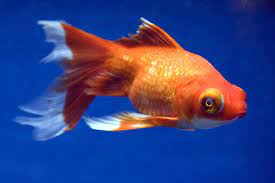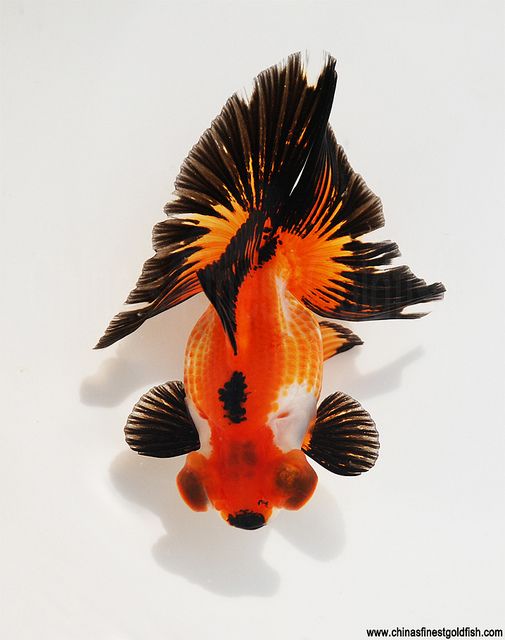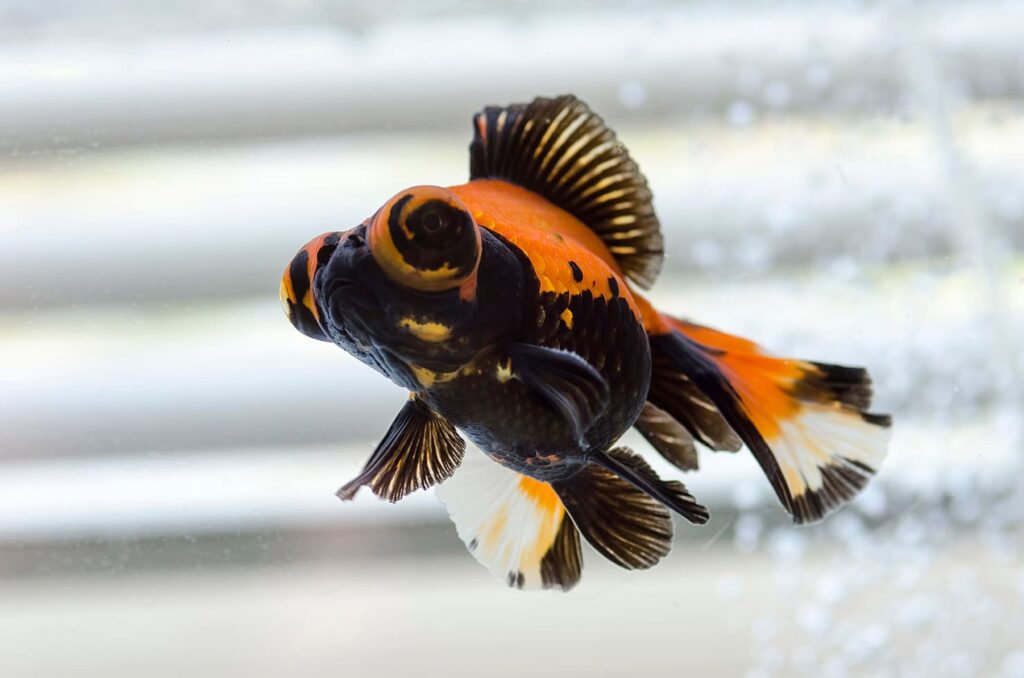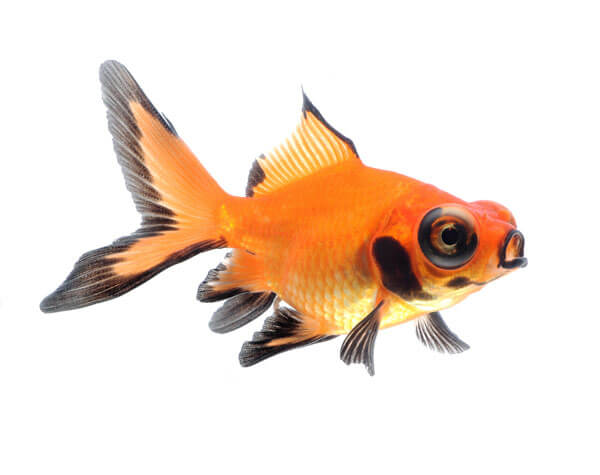Butterfly Telescope goldfish are a beautiful variant of the popular Moor fantail goldfish. These fish can bring an exotic look to a coldwater aquarium, but caring for them can be challenging for a beginner.
In our guide, we provide all the information and tips you need to successfully keep these stunning and unusual fish in your home tank or pond. So, keep reading to find out more about the enigmatic Butterfly Telescope goldfish.
Key Takeaways:
- Origins & History: Butterfly Telescope goldfish, a variant of Moor fantails, were first described in 1994 and are a popular Telescope goldfish breed.
- Physical Characteristics: Known for their protruding eyes, butterfly-shaped tails, and egg-shaped bodies, they are slow swimmers.
- Lifespan: They live 10-15 years on average, but with good care, can exceed 20 years.
- Size: Grow up to 6 inches long, so a spacious tank is essential.
- Color & Patterns: Available in colors like blue, red, white, and black, with metallic or nacreous scales.
- Price & Availability: Commonly sold for about $10, but rare colors can be more expensive.
- Care Needs: Require a 10-gallon tank, efficient filtration, proper water parameters, and regular maintenance.
- Tank Mates: Best kept with slow-moving fancy goldfish, avoiding faster species.
- Health & Diseases: Susceptible to eye injuries, white spot disease, bacterial infections, and cloudy eye.
- Breeding: They are egg layers and need the right conditions for spawning, like temperature control and high-quality food.
Origins Of The Butterfly Telescope Goldfish

All goldfish, scientific name Carassius auratus, are thought to originate from China, where they were developed from a species of wild Prussian carp in the early 1700s.
The species is a variant of the popular Moor or Telescope fantail goldfish that were once known as Dragonfish or Dragon Eye goldfish. Today, all Telescope Eye goldfish are referred to in Asia as Demekins.
All fancy fantail goldfish, including the Butterfly Telescope goldfish, are captive-bred, so you won’t see these fish in the wild environment. The Butterfly Telescope goldfish was first described in 1994 by Teichfischer.
What is a Butterfly Telescope Goldfish?

Butterfly Telescope goldfish are one of over 200 varieties of goldfish, and they are considered to be one of the most beautiful.
These unusual fish are so named for their distinctive protruding eyes that are mounted on ¾ inch stalks on the side of the fish’s head. Interestingly, in young fish, the eyes appear normal until the fish reaches around six months of age.
Butterfly Telescope goldfish have caudal or tail fins that are butterfly-shaped when viewed from above, hence the variety’s popular name. In the most high-quality specimens, the tail spread should be 180 degrees, although that can depend on the weight of the fins that sometimes droop downward.
Butterfly Telescope goldfish have round, egg-shaped bodies, and a clumsy, wobbling swimming style. That can cause problems if the fish are housed with faster, more agile swimmers, especially at feeding times.
Like all goldfish, the Butterfly Telescope goldfish is a coldwater species that can live in a home aquarium or outside in a large pond.
Butterfly Telescope Goldfish Lifespan
Goldfish are a relatively long-lived species, with some individuals surviving for up to 30 years when given the highest quality care.
Butterfly Telescope fancy goldfish generally live for an average of between ten and 15 years. However, when kept in a well-maintained aquarium or garden pond and fed a high-quality diet, a lifespan of over 20 years can be achieved.
What Size Are Butterfly Telescope Goldfish?
When you buy any species of goldfish from your local fish store, you are usually purchasing a small juvenile specimen of around three to six months old.
Don’t be fooled! That inch-long fish will grow very quickly, often doubling in length in a matter of weeks if kept in a healthy tank and fed a varied, balanced diet. That’s why many goldfish end up living in tanks that are much too small for them.
Telescope goldfish can reach up to 6 inches in length when full-grown. So, you must bear that in mind when choosing an aquarium for your new pet.
Colors And Patterns
The Butterfly Telescope goldfish comes in a huge range of colors and patterns, including:
- Blue
- Red
- White
- Tri-color
- Chocolate
- Bi-color
- Calico
- Black-and-white (Panda)
- Black Moor
There’s also a rare, seldom-seen example of this fish that’s chocolate with bright orange pom-poms.
Generally, the fish’s scales are metallic or nacreous, although you might occasionally find a rare matte version.
Price And Availability
Butterfly Telescope Goldfish are generally readily available to buy in good pet stores for around $10.
You can also sometimes find these fish offered in more unusual colors and patterns by breeders who advertise their stock online, but those specimens will be more expensive.
Is The Butterfly Telescope Goldfish Suitable For Beginners?
These gorgeous fish are not the best goldfish variety for a beginner without experience of keeping goldfish to take on.
Goldfish do not have a stomach as we do. Instead, the fish extracts nutrients from the food as it passes through its intestines. So, a goldfish is effectively a swimming food processor, producing vast amounts of waste as it moves around your tank.
For that reason, you need a powerful mechanical and biological filtration system to cope with the amount of waste that goldfish produce. Regular maintenance and water changes are necessary to prevent harmful toxins from accumulating in the water.
The Butterfly Telescope goldfish’s protruding eyes are prone to injury and damage.
Butterfly Telescope Goldfish Care Guide
In this part of our guide, you can learn how to care for these beautiful fish.
Tank Size
As previously mentioned, Butterfly Telescope goldfish can grow to be quite large, often reaching 6 inches or even more in length.
All fancy goldfish varieties grow pretty quickly during the first two or three years of their life, so we recommend that you buy a large tank. It’s an urban myth that fish grow to fit the size of their container. However, if the aquarium is too small, your goldfish won’t thrive, and their growth will most likely be somewhat stunted.
So, for Butterfly Telescope goldfish, you need a 10-gallon tank as a bare minimum, increasing the tank size by ten gallons per fish. A rectangular tank is the best choice for fancy goldfish. Although the fish will swim in all areas of the tank, fancies are not very agile swimmers, and a deep tank can cause problems when it comes to surface feeding.
A rectangular tank will provide a greater surface area for gaseous exchange, helping to oxygenate the water for these oxygen-hungry creatures.
How Many Fish Can You Keep?
Although Butterfly Telescope goldfish enjoy the company of other fancy goldfish, they need lots of space. If the tank is too crowded, the fish will become stressed, leading to outbreaks of disease and poor growth rates.
As a basic rule of thumb, you should allow 1 inch of fish per 1 gallon of water in the tank. Although your tiny juvenile fish might appear swamped in a 20-gallon tank, they will soon grow, so plenty of space is essential.
Water Parameters
Goldfish thrive in cool water between 65o and 72o Fahrenheit. The pH level in the tank needs to be in the range of 6.0 to 8.0, with the water hardness between 5 and 19 dGH.
Levels of ammonia and nitrite should always be zero, and nitrates should be 20 ppm or less.
Filtration
Although they are undoubtedly beautiful, Butterfly Telescope goldfish are filthy creatures that produce a lot of waste. For that reason, you must install an efficient filtration system in your aquarium or pond.
Ideally, you need a filter system that circulates the water around your tank at least four times every hour. The filter should have both mechanical and biological filter media to keep the water clean and safe for your fish.
Fancy goldfish types are notoriously poor swimmers and they don’t cope well with a strong current in the tank. That can be a problem since you do want a decent level of flow to pass the water through the filter media. So, choose a filter system that has an adjustable outflow valve, or buffer the flow with plants or decorations.
Tank Maintenance
As well as providing the correct size tank and an efficient filtration system, good housekeeping and tank maintenance are crucial for the health of your Butterfly Telescope goldfish.
So, every week you need to carry out a partial water change of up to 30% to keep nitrate levels down and relieve the burden on the biological filter system. Use an aquarium vacuum cleaner to remove organic waste and uneaten food from around the base of plants, underneath decorations, and in problem areas, such as the tank corners and under internal filter boxes.
Trim dead leaves from living plants and use an algae scraper to clear the viewing panes of problem algae. You might want to leave some algae on the rear pane, as the fish will happily graze on that throughout the day.
Tank Decoration
Since goldfish are not found in the wild environment, the aquarium décor scheme you choose is largely up to your personal choice. However, there are a few important things to bear in mind when aquascaping a goldfish tank.
Safety First!
Butterfly Telescope goldfish have luxuriant, floating fins and protruding eyes. So, be very careful that you don’t include any decorations or ornaments that could snag the fish’s fins or damage their eyes.
These fish have pretty poor vision and are not good swimmers, so it’s a good idea to leave an ample, clear swimming space in the center of the tank and place your hardscape items around the perimeter of that.
Natural décor shows off goldfish very well, so use driftwood, twisted roots, smooth stones, and pebbles to decorate the tank. Goldfish spend much of their time scavenging on the tank floor for scraps of food, and large gauge gravel works well as a substrate.
Planting
Living plants are highly beneficial for your aquarium, helping to oxygenate the water and taking up nitrates for use as fertilizers. However, plants are also vulnerable to attack by your Butterfly Telescope goldfish!
Goldfish are serial diggers, rooting about in the substrate for food scraps and uprooting plants in the process. Also, the fish are omnivores that enjoy snacking on fresh leaves and plant shoots. However, there are several species of hardy aquatic plants that will survive in a goldfish tank, including Marimo Moss Balls, Anubias, and Java Fern.
Lighting
Your goldfish don’t actually need light to survive.
However, if you have live plants in your setup, they will require at least eight hours of light every day for photosynthesis. Also, using lighting in your tank can provide an authentic day/night environment that effectively tells the fish when they should be active and feeding and when it’s time to sleep.
Without those clear day and night parameters, the fish can become stressed, which eventually leads to health problems. So, if you can’t be around to manually turn the lights on and off, it’s well worth investing in an automatic timer or choosing a light unit that has one included.
Nutrition and Feeding
Goldfish are greedy, omnivorous fish that will eat pretty much anything you offer them!
So, a basic diet for your pets could include high-quality fish flakes and pellets, as well as some frozen meaty protein and some blanched fresh veggies, such as zucchini, peas, and lettuce. The fish will also eat algae and plant matter that occurs naturally in your aquarium or pond. Pond-kept fish will also feed on insect larvae, small crustaceans, and general detritus that they find in their environment.
Butterfly Telescope goldfish are typical of all fancy goldfish types in that they are vulnerable to digestive problems, especially constipation and bloating. Those conditions are usually caused by a build-up of dried food in the fish’s intestines. A constipated fish will usually have difficulty swimming on an even keel, often floating up to the surface or swimming on one side. However, you can prevent these issues by giving your fish some frozen bloodworms, brine shrimp, or similar each day.
How Much To Feed?
Goldfish should be fed two or three small meals every day. Offer your fish only what they will clear in a couple of minutes to avoid overfeeding.
What Are Good Tank Mates For Butterfly Telescope Goldfish?
Goldfish are peaceful fish that generally do best when kept in groups. The best tank mates for Butterfly Telescope goldfish are other varieties of fancy goldfish, including Lionhead goldfish, Celestial goldfish, Black Moors, and Bubble Eye goldfish. Slim-bodied goldfish are best avoided as they are much faster swimmers that might outcompete the slower fancies for food.
Shrimp and snails can make good tank mates for goldfish, and they can be useful as a cleanup crew. However, always choose large varieties of shrimp that won’t end up as lunch for your goldfish, and pick snail species that won’t make a meal of your plants!
Avoid housing fish that are known to be fin nippers or very tiny species that might be viewed as a food source by the goldfish.
Health and Diseases
Goldfish are generally a pretty hardy species that will remain healthy, provided they are housed in a suitable environment with peaceful tank mates and fed a high-quality, varied diet. However, there are a few health problems that can affect the Butterfly Telescope goldfish.
Eye Injuries
Telescope goldfish are prone to eye problems, largely caused by collisions with tank decoration items or other fish during feeding times. Eye injuries can result in bacterial infections, which could even mean the fish losing an eye.
Be extremely careful if you need to net your fish, as those protruding eyes can easily become snagged in the net, causing further injury. If you must net your fish, choose a net with a very fine mesh.
White Spot Disease
White Spot Disease is also known as Ich or Ick.
The disease is caused by an aquatic parasite that is present in most freshwater aquariums, only attacking fish that are weakened by disease or stress. Fish with Ich flick or rub against the substrate and other solid surfaces in the tank in an effort to remove the irritating parasites on their skin. After a few days, a rash of tiny white spots appears on the fish’s body, gills, fins, and tail.
White Spot Disease is easily treatable with an over-the-counter medication that you’ll find in your local fish store.
Bacterial Infections
Bacterial infections usually affect fish that are injured or weakened by stress. Symptoms vary, depending on the variety of bacteria but can include:
- Ulcers
- Reddened areas on the skin
- Lethargy
- Torn or ragged fins
- Missing scales
- Loss of appetite
- Labored breathing
Again, most bacterial infections can be treated with a proprietary medication that you can buy in fish stores.
Flukes
Fluke is the umbrella term that’s used to describe the many external parasites that can affect goldfish, including:
- Anchor worms
- Fish lice
- Skin flukes
Flukes are usually introduced into the aquarium as hitchhikers on plants, live food, or new fish. You can prevent these unwanted invaders from attacking your livestock by placing anything new in a quarantine tank for at least two weeks before adding the newbies to your tank.
Cloudy Eye
Cloudy Eye is a condition that commonly affects Telescope goldfish.
The condition can affect one or both eyes and can sometimes cause blindness. Cloudy Eye is usually caused by poor water quality and is, therefore, easily preventable by good aquarium husbandry.
Breeding Butterfly Telescope Goldfish

Goldfish of all species will breed pretty readily in a pond or tank, providing that they are given a varied diet and the correct water conditions.
Of course, you need to have a mixture of male and female fish if your breeding project is to be a success. Generally, female goldfish are rounder in shape than males, and male fish develop white prickles called tubercles on the gill covers and head.
Spawning Conditions
Butterfly Telescope goldfish are egg layers, spawning when the water warms up in the spring like their wild carp relatives.
Your fish must be well-fed and healthy, and you’ll need to provide a large tank of at least 20 gallons to encourage spawning. The tank should be heavily planted with some flat stones or spawning mops on which the fish can lay their eggs.
To trigger spawning, gradually increase the water temperature in the spawning tank by 3o every day until it reaches between 68o and 74o Fahrenheit. Perform 20% water changes every day until breeding begins, and feed the fish plenty of high-quality, protein-heavy foods, including brine shrimp and bloodworms.
Spawning
During the spawning process, the male Butterfly Telescope goldfish pursues the female around the aquarium, pressing against her to encourage her to lay her eggs. Once the eggs are laid, the male fertilizes them. Spawning can continue for several hours, during which time up to 10,000 eggs might be laid.
To prevent the parents from eating their eggs, the goldfish should be removed as soon as the eggs are fertilized.
The eggs should hatch after around seven days. The fry is free-swimming immediately after hatching and can be offered commercially produced fry food until the babies are large enough to cope with crushed fish flakes and live baby brine shrimp.
Your juvenile Butterfly Telescope goldfish will be rather drab brown or black in color to camouflage them against potential predators. However, the fish will begin to show their adult coloring within a few months. When the youngsters are around an inch or so in length, they can be safely placed in your main tank with the adults.
Final Thoughts
Butterfly Telescope goldfish can make a beautiful addition to an established goldfish tank or garden pond.
These fish do need plenty of space to thrive, so a tank of at least 10 gallons is essential, and you must have a highly efficient filtration system to cope with the amount of waste they produce. Butterfly Telescope goldfish are relatively straightforward to keep, but they do best with a group of similar fancy types in a safe environment with plenty of open swimming space.
FAQs (Frequently Asked Questions)
- What is the largest telescope goldfish?
- The largest variety of telescope goldfish is the Broadtail Moor, known for its impressive size and distinctive telescope eyes. These fish can grow up to 10 to 12 inches or even larger under optimal conditions.
- How big do black butterfly goldfish get?
- Black Butterfly Goldfish, like other telescope varieties, can reach a size of 6 to 8 inches in a well-maintained aquarium. However, factors such as genetics, diet, and tank conditions can influence their growth.
- How big do black butterfly goldfish get?
- As mentioned earlier, Black Butterfly Goldfish typically grow to a size of 6 to 8 inches. Providing them with a spacious and well-filtered tank, along with a balanced diet, contributes to their overall health and size.
- What do you feed butterfly tail goldfish?
- Butterfly Tail Goldfish, like other varieties, thrive on a varied diet. High-quality flakes, pellets, and live or frozen foods such as brine shrimp or bloodworms are suitable. It’s essential to maintain a balanced diet to ensure their well-being and vibrant colors.
Do you keep Butterfly Telescope goldfish? Did you successfully breed from your fish? Tell us your story in the comments box below.
